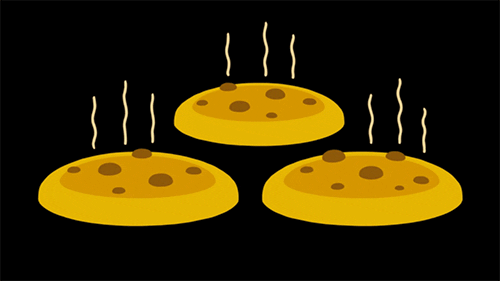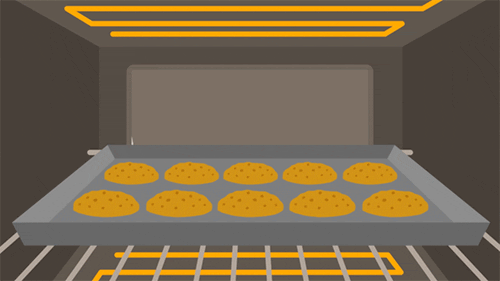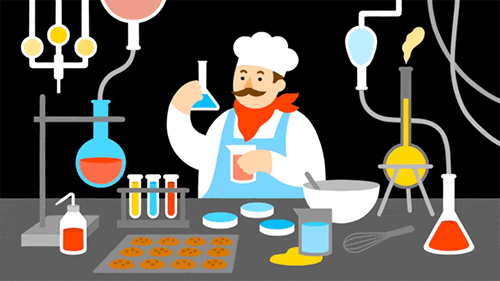Grading A Slew Of Mediocre Final Papers, The Grad Student Watches His Months Of Arduous Teaching Bear

Grading a slew of mediocre final papers, the grad student watches his months of arduous teaching bear little fruit.
More Posts from Smparticle2 and Others
5 Cookie Pro Tips from TED-Ed (and Science)

1. Cookies are for everyone. But everyone has cookie preferences. When you slide that cookie tray into the oven, you’re setting off a series of chemical reactions that transform one substance - dough - into another - cookies! The better you understand ‘Cookie Chemistry’, the better equipped you will be to create the cookies you crave.

2. Lots goes on in that oven, but one of science’s tastiest reactions occurs at 310º. Maillard reactions result when proteins and sugars breakdown and rearrange themselves into ring like structures which reflect light in a way that gives foods their distinctive, rich brown color. As this reaction occurs, it produces a range of flavor and aroma compounds, which also react with each other forming even more complex tastes and smells.

3. The final reaction to take place inside your cookie is caramelization and it occurs at 356º. Caramelization is what happens when sugar molecules breakdown under high heat, forming the sweet, nutty and slightly bitter flavor compounds that define…caramel! So if your recipe calls for a 350º oven - caramelization will never happen.
So, if your ideal cookie is barely browned - 310º will do. But if you want a tanned, caramelized cookie, crank up the heat! Caramelization continues up to 390º degrees.

4. No need to check that oven like a fiend. You don’t even really need a kitchen timer - when you smell the nutty, toasty aromas of the Maillard reaction and caramelization, your cookies are ready!

5. Baking is chemistry, friends! That’s right - PURE. SCIENCE. Check carefully before altering those recipes - chances are some of those ingredients and quantities are there for a reason.
Curious what else happens in that oven? Check out the TED-Ed Lesson The chemistry of cookies - Stephanie Warren
Animation by Augenblick Studios





How to Beam ➝ Noemi Makra Style

Henry Cabot Lodge Jr. presenting “The Thing” to the Security Council at the United Nations. 26 May 1960.
via reddit
Keep reading





Behind a TED-Ed Lesson: Animation + Inspiration
To celebrate George Seurat’s birthday today, we thought we’d do a deep dive behind the scenes of one of our animated lessons, How do schools of fish swim in harmony?, which is about the concept of ‘emergence’ and whose animated style just so happens to have been largely influenced by the paintings of George Seurat and his contemporaries.

Emergence refers to the spontaneous creation of sophisticated behaviors and functions from large groups of simple elements, and can be used to explain the movements of ants, fish, and birds, as well as how the tiny cells in your brain give rise to the complex thoughts, memories, and consciousness that are you.

A Sunday Afternoon on the Island of La Grande Jatte, George Seurat (1884–86)
It’s kind of like a pointillist painting. When you zoom in real close, it’s just a collection of chaotic brush strokes. But take a few steps back, and you’ll see that all of those brush strokes are working together to illustrate a complex and detailed scene.

Pointillism stems from Impressionism, and depending on the artist’s technique, the size of the brush strokes vary, but are always visible. For example, Vincent van Gogh’s The Starry Night uses larger brush strokes in the night sky. Both the above and below concept designs show the animator of this lesson testing out how different brushstrokes interact to create depth within a scene. She decided that the swirling waters would make sense as large brushstrokes, which also offered contrast to allow the small fish to stand out.

George Seurat also employed a technique called ‘divisionism’, sometimes known as ‘chromoluminarism’, in which colors were separated into individual dots or patches which interacted optically. So, rather than relying on mixing colors, painters like Seurat and Paul Signac juxtaposed contrasting colors to allow for optical mixing - which in theory would produce more vibrant and pure colors than the traditional process of mixing pigments.

Circus Sideshow (Parade de Cirque), George Seurat (1887–88)
While designing this TED-Ed lesson, George Seurat and Paul Signac’s paintings provided inspiration not just for the brushstroke technique, but also for the color palette.

This GIF of the brain and it’s neural connections draws many of its colors from Seurat’s circus series palette, while the brighter colors - such as the ones used in the title GIF above - are drawn from the more vibrant colors commonly used by Paul Signac, like in the painting below.

Notre-Dame-de-la-Garde (La Bonne-Mère), Marseilles, Paul Signac (1905-06)

Animating this lesson was an opportunity to renew a sense of wonder in our ever complex universe, whether studying it up close or from afar. We hope that watching it might do the same for you!
From the TED-Ed Lesson How do schools of fish swim in harmony? - Nathan S. Jacobs
Animation by TED-Ed // Lisa LaBracio

Good vibrations no longer needed for speakers as research encourages graphene to talk
A pioneering new technique that encourages the wonder material graphene to “talk” could revolutionise the global audio and telecommunications industries.
Researchers from the University of Exeter have devised a ground-breaking method to use graphene to generate complex and controllable sound signals. In essence, it combines speaker, amplifier and graphic equaliser into a chip the size of a thumbnail.
Traditional speakers mechanically vibrate to produce sound, with a moving coil or membrane pushing the air around it back and forth. It is a bulky technology that has hardly changed in more than a century.
This innovative new technique involves no moving parts. A layer of the atomically thin material graphene is rapidly heated and cooled by an alternating electric current, and transfer of this thermal variation to the air causes it to expand and contract, thereby generating sound waves.
Read more.

How do you build a metal nanoparticle?
Novel theory explains how metal nanoparticles form
Although scientists have for decades been able to synthesize nanoparticles in the lab, the process is mostly trial and error, and how the formation actually takes place is obscure. However, a study recently published in Nature Communications by chemical engineers at the University of Pittsburgh’s Swanson School of Engineering explains how metal nanoparticles form.
“Thermodynamic Stability of Ligand-Protected Metal Nanoclusters” (DOI: 10.1038/ncomms15988) was co-authored by Giannis Mpourmpakis, assistant professor of chemical and petroleum engineering, and PhD candidate Michael G. Taylor. The research, completed in Mpourmpakis’ Computer-Aided Nano and Energy Lab (C.A.N.E.LA.), is funded through a National Science Foundation CAREER award and bridges previous research focused on designing nanoparticles for catalytic applications.
“Even though there is extensive research into metal nanoparticle synthesis, there really isn’t a rational explanation why a nanoparticle is formed,” Dr. Mpourmpakis said. “We wanted to investigate not just the catalytic applications of nanoparticles, but to make a step further and understand nanoparticle stability and formation. This new thermodynamic stability theory explains why ligand-protected metal nanoclusters are stabilized at specific sizes.”
Read more.









Tuz Gölü - Cereal / WORDS & PHOTOS: Peter Edel
FOR THE AMERICAN COLOUR FIELD PAINTER BARNETT NEWMAN, THE EMPTY, BOUNDLESS LANDSCAPE ENHANCED AN INDIVIDUAL’S SENSE OF PRESENCE WITHIN THEM. THE TUZ GÖLÜ, THE SALT LAKE LOCATED IN THE CORE OF TURKEY’S ANATOLIAN PENINSULA, IS ONE OF THE PLACES IN THE WORLD WHERE THIS UNDERSTANDING IS EXPERIENCED MOST PROFOUNDLY.
-
 wiskundewezen liked this · 1 year ago
wiskundewezen liked this · 1 year ago -
 undecized liked this · 1 year ago
undecized liked this · 1 year ago -
 aktaion liked this · 1 year ago
aktaion liked this · 1 year ago -
 phrankquey liked this · 2 years ago
phrankquey liked this · 2 years ago -
 feralpussylover reblogged this · 2 years ago
feralpussylover reblogged this · 2 years ago -
 feralpussylover liked this · 2 years ago
feralpussylover liked this · 2 years ago -
 sonoroustempest liked this · 3 years ago
sonoroustempest liked this · 3 years ago -
 the-art-of-being-here liked this · 4 years ago
the-art-of-being-here liked this · 4 years ago -
 baibaisnowprincess reblogged this · 4 years ago
baibaisnowprincess reblogged this · 4 years ago